|
|
|
Sort Order |
|
|
|
Items / Page
|
|
|
|
|
|
|
| Srl | Item |
| 1 |
ID:
113950
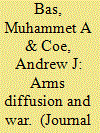

|
|
|
|
|
| Publication |
2012.
|
| Summary/Abstract |
The authors present a model of the relationship between the spread of new military technologies and the occurrence of war. A new technology could shift the balance of power, causing anticipatory war as one side tries to prevent the other from obtaining it. When one side already has it, war is more likely when the shift in power is large, likely, and durable. When neither side has it, war is more likely when the expected shift is asymmetric (e.g., one side is more likely to get it) and when the two sides fear that a war will occur once one of them has it. The authors illustrate the model with historical examples from the spread of firearms (the Musket Wars in precolonial New Zealand) and of nuclear weapons (the end of US nuclear monopoly and the 1967 Six-Day War). A broader implication is that major power competition can unintentionally cause wars elsewhere.
|
|
|
|
|
|
|
|
|
|
|
|
|
|
|
|
| 2 |
ID:
113953
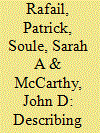

|
|
|
|
|
| Publication |
2012.
|
| Summary/Abstract |
Numerous scholars have observed a decline in more coercive police tactics used to control demonstrations since the 1960s in North America and Western Europe. Such claims, however, are largely based on rather unsystematic observation, and almost no research directly examines the evolution of protest policing during this entire period. To address this gap, the authors use semiparametric logistic regression to examine reported police presence, the use of arrests, and the use of force at 15,965 US protests occurring between 1960 and 1995. The results confirm that while there has been an absolute decline in more repressive policing behavior, the transitional process was not a monotonic, linear process. The authors also investigate the different evolutionary patterns of each type of protest policing. The authors further demonstrate that African American initiated events, government targets, social movement organization presence, protest forms, the use of force, and arrests have variable impacts on police responses over time.
|
|
|
|
|
|
|
|
|
|
|
|
|
|
|
|
| 3 |
ID:
113951
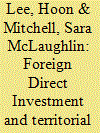

|
|
|
|
|
| Publication |
2012.
|
| Summary/Abstract |
This study evaluates the relationship between foreign direct investment (FDI) and interstate conflict, focusing on four prominent causal mechanisms: the declining benefits of territorial conquest, increasing preference similarity, increasing opportunity costs of violence, and improved information signaling. Empirical analyses show that new territorial issues are less likely to arise as global levels of FDI increase, although monadic and bilateral FDI flows have no effect on states' decisions to start new issue claims. Higher bilateral FDI flows between two disputants significantly reduce the chances for escalation to high levels of violence over issues and improve the chances for peaceful management. Increasing global levels of FDI also reduce the chances for severe militarized conflicts. Opportunity costs are an important mechanism linking FDI and states' conflict management practices, as the pacifying effect of bilateral and monadic FDI on militarized conflict becomes stronger in dyads with a history of militarization over the issues at stake.
|
|
|
|
|
|
|
|
|
|
|
|
|
|
|
|
| 4 |
ID:
113948
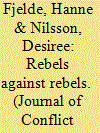

|
|
|
|
|
| Publication |
2012.
|
| Summary/Abstract |
Rebel groups that confront the government frequently become engaged in fierce and violent struggles with other groups. Why does a rebel group who is already fighting with the government become engaged in yet another struggle, thereby sacrificing scarce resources in the fight against other rebel groups? This article addresses this puzzle by providing the first global study on the determinants of interrebel violence. The authors argue that this violence should be understood as a means to secure material resources and political leverage that can help the group prevail in the conflict with the government. The quantitative analysis builds on new data on armed conflict between nonstate actors, 1989-2007. The results show that interrebel conflict is more likely when the rebel group fights in an area with drug cultivation, when the group is in control of territory beyond government reach, when the group is either militarily strong or weak in relation to other rebels, and where state authority is weak.
|
|
|
|
|
|
|
|
|
|
|
|
|
|
|
|
| 5 |
ID:
113947


|
|
|
|
|
| Publication |
2012.
|
| Summary/Abstract |
The large-n literature on political violence has paid little attention to the distinction between insurgencies that control territory and those that do not. Territorial control has consequences for the lethality of the group, its pattern of recruitment and bargaining power. The main determinant of territorial control, we argue, is state capacity: while territorial insurgencies are more frequent in poor countries, nonterritorial ones tend to occur in countries with intermediate levels of development (rich countries are free of internal violence). The authors show that the relationship between development and nonterritorial violence is a concave one, using a panel for the period 1970-1997 that combines existing data sets on civil wars and the Global Terrorism Database 1. The authors also find that nonterritorial violence is more likely in democratic, old states. Population, rough terrain, and inequality have a similar impact on both types of conflict. The authors discuss to what extent territorial conflicts correspond to civil wars and nonterritorial ones to terrorism.
|
|
|
|
|
|
|
|
|
|
|
|
|
|
|
|
| 6 |
ID:
113952
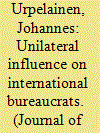

|
|
|
|
|
| Publication |
2012.
|
| Summary/Abstract |
The conventional wisdom emphasizes agency slack or bias as the central problem of international delegation. I show that the possibility of a unilateral influence contest is equally problematic. States can exert unilateral influence on autonomous international bureaucrats, either through rewards or through punishments, to pursue their particular interests. A costly contest results, so some states could refuse to delegate because they expect others to be too influential. The analysis has four counterintuitive empirical implications. First, international agreements often favor institutionally weak states that are disadvantaged in the unilateral influence contest. Second, states could limit the autonomy of an international organization even if this prompts bad policies. Third, a state can sometimes profitably exchange distributional concessions for autonomy. Finally, constraints on unilateral influence are possible only if a disadvantaged state can credibly commit to compensating an advantaged state for it. A central broader contribution of the analysis is to show how power politics influences the rational design of international institutions.
|
|
|
|
|
|
|
|
|
|
|
|
|
|
|
|
| 7 |
ID:
113949
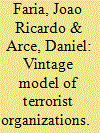

|
|
|
|
|
| Publication |
2012.
|
| Summary/Abstract |
A dynamic model of a terrorist organization is presented with the defining feature being that a succession of operatives is recruited at different points in time. Consequently, a government's counterterror policy must be tailored according to the vintage structure of the terrorist group that it faces. This implies that past history of counterterror policy and attacks matter for the formulation of current and future policy. The authors present the necessary steps to formulate and solve a vintage model, and to deal with the delay differential equations that naturally arise from the vintage structure. The resulting analysis captures the implications of a diverse set of phenomena such as Internet recruiting, training delays for logistically complex plots, age distribution of operatives, and the sensitivity of government impatience/cabinet composition to terrorist events for the inner dynamics of terrorist organizations and counterterror policy. Directions for future research are also suggested.
|
|
|
|
|
|
|
|
|
|
|
|
|
|
|
|
|
|
|
|
|